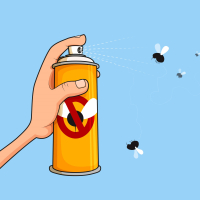
Key messages
• Topical repellents may slightly reduce the incidence and prevalence of malaria caused by Plasmodium falciparum.
• These changes seem to be particularly important in high-risk populations, specifically in refugees living in camps where there are fewer other options.
• Topical repellents may make little or no difference in malaria prevalence and incidence in settings where insecticide-treated nets, and other options to control the transmission of malaria are readily available.
What is malaria?
Malaria is a disease caused by at least five species of parasites from the genus Plasmodium, and spread by the bite of Anopheles mosquitoes. The disease regularly affects people in tropical areas of Central and South America, South and Southeast Asia, and particularly, Africa. Over 247 million malaria cases and 619,000 deaths occurred in 2021, mostly in Africa. The disease affects the function of red blood cells, which transport oxygen through the body. This generally causes fever, malaise (a feeling of 'just not feeling well'), and other mild symptoms. However, some people can develop complicated disease, which is associated with a severe reduction in the number of circulating red blood cells, and problems in the liver, brain, and other organs.
Malaria can be treated with different medicines, which are generally effective. Certain tools that prevent mosquito bites, like nets treated with insecticides, can protect people from getting it, and have helped to significantly reduce the number of cases around the world. Nonetheless, most of these approaches target mosquitoes that feed indoors and on humans. They are less effective against species that can feed outdoors, so do not really eliminate the disease.
What did we want to find out?
The aim of this Cochrane Review was to find out if topical insect repellents (substances applied to the skin to prevent mosquito bites) can prevent malaria in people living in regions where this disease occurs regularly. We were particularly interested in their effect on people who might not be adequately protected by other measures, which are more commonly used to prevent malaria.
We wanted to find out if topical repellents were better than a placebo, or no intervention at all, to reduce two indicators of malaria transmission:
• Malaria incidence (the number of new cases in a period of time);
• Malaria prevalence (the number of all cases at a certain moment).
We also wanted to know if topical repellents caused any adverse side effects to people who used them.
What did we do?
We searched the existing literature for studies that compared the effect of topical repellents (alone or in combination with other tools to prevent mosquito bites) with a placebo or no intervention. We compared and summarized the results of the included studies, and rated our confidence in the evidence they provided, based on the methods used in each one.
What did we find?
We included a total of eight studies, which included over 60,000 people. The studies took place in areas with low malaria transmission, mostly in Southeast Asia and South America.
The topical repellents evaluated included lotions, soaps, and cosmetics. We found evidence suggesting that topical repellents may slightly reduce the incidence and prevalence of malaria cases caused by P falciparum in settings where other tools to prevent mosquito bites are not available. Despite this, our findings suggest that repellents probably make little or no difference in places where these tools are already widely used. Topical repellents are considered safe, and the prevalence of adverse side effects was very low.
What are the limitations of the evidence?
The benefits of topical repellents were particularly clear among refugees. However, shortfalls in the design of the included studies did not allow us to generalize these observations to other contexts. We only included cases of malaria caused by the parasite P falciparum. We also recognize that studies measured and reported adherence differently, and often did not know if the participants actually used the repellent as advised.
How up to date is this review?
The evidence is up to date to 11 January 2023.

